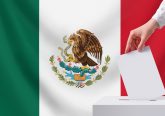On October 1st, Claudia Sheinbaum will be sworn in as the first female president in Mexico’s history. As president, Sheinbaum will have to address pressing issues that require domestic, bilateral, and regional cooperation, among them transit migration.
Since taking office in 2018, Mexico’s current President Andrés Manuel López Obrador (AMLO) has promised to adopt a human rights approach to address transit migration, but throughout his presidency he has continued to implement policies that have further militarised migration routes and criminalised migrants seeking to reach the US, pushing many to take more dangerous routes. In 2023, the International Organization for Migration (IOM) found the US-Mexico border to be the world’s deadliest migration land route for migrants.
Given the unprecedented levels of violence, how will Sheinbaum address transit migration? How will her agenda differ from that of her predecessor AMLO? Sheinbaum’s migration agenda will not differ significantly from AMLO’s. Sheinbaum’s administration will likely continue to design migration policies in dialogue with the US government. Specifically, the incoming administration will continue to seek financial assistance from the US government to address the root causes of migration in Central and South America and collaborate in deterring migrant flows from reaching the US – not because Mexico lacks agency but rather as a strategy to advance domestic interests and strengthen bilateral relations with the US government.
Transit migration in Mexico and its management
While transit migration has been an ongoing phenomenon in Mexico since the early 1980s, it has increased and diversified over the last decade. From 2022 to 2023, there was a 77% increase in migrant encounters at Mexico’s southern border. While most migrants come from Central and South America, Mexico has also seen an increase in transnational migration, with migrants coming from countries like India, Senegal, China, and Bangladesh. For example, Mexican immigration authorities in the northern border city of Tijuana have processed migrants from over 125 countries. Furthermore, those transiting through Mexico are no longer predominantly single men. Since 2014, more people have been transiting Mexico in larger groups as a strategy for survival and safety. The number of ‘family units’ and unaccompanied minors transiting through Mexico has also increased significantly. From 2022 to 2023, approximately 20,000 minors were transiting through Mexico. Unpacking changes in the migrant population is crucial. NGOs and collectives have been the main supporters of the diverse needs of migrants in transit. They have opened shelters tailored to specific demographic groups, provided translation services, and helped migrants access social rights.
In terms of the Mexican government’s response to transit migration, the AMLO administration has continued to implement policies focused on militarisation and deterrence. As of 2023, there are 54 migrant detention centres in 26 Mexican states and 348 ‘provisional’ migrant detention centres. Furthermore, Mexico’s National Migration Institute (INM) operates 198 migration checkpoints across the country. Migrants face neglect and violence at the hands of INM officials. On March 27, 2023, 40 migrants died after a fire broke out in a migrant detention centre in the border city Ciudad Juarez just a few miles from El Paso, Texas. Furthermore, raids, and other migration operatives are not only conducted by Mexican immigration officials but also in collaboration with the National Guard, and state and local police enforcement. The INM and the National Guard have been accused of raiding shelters and harassing migrants. In 2023, both parties raided Border Line Crisis Center, a shelter in Tijuana for women and children. In 2021, the National Guard killed a Cuban migrant after opening fire at a pick-up truck carrying migrants. That same year, a Guatemalan migrant was killed by Mexican soldiers at a migrant checkpoint. Migrants in transit face various forms of violence from the INM, the National Guard, and law enforcement agencies, forcing them to use dangerous routes controlled by criminal organisations.
At the same time however, Mexico has gradually become a country of destination not only for middle and upper-class foreigners but also for those seeking asylum. In 2023, the Mexican Commission for Refugee Aid (COMAR) received 140,982 asylum applications. From 2022 to 2022 COMAR saw 29% increase in asylum applications, the highest increase the agency has documented. However, since 2017 COMAR’s funding has not increased at the same rate as refugee applications. In 2020, COMAR requested an annual budget of $6.2 million, but the Mexican Congress only allocated $ 2.4 million. The COMAR faces many challenges, including limited staff and a limited budget to process applications in a timely manner.
Sheinbaum’s migration policies: How will they address ongoing challenges?
Although migration was not a key issue in Sheinbaum’s presidential campaign, during the presidential debates she provided some insight into how she would manage migration. Sheinbaum emphasised the need to adopt a framework that focuses on protecting the rights of migrants, particularly those transiting through Mexico. The president-elect also stressed the importance of addressing the ‘root causes’ of migration by implementing development initiatives in southern Mexico and sending aid to Central and South America. Additionally, Sheinbaum underscored the need to restructure the INM and COMAR.
However, Sheinbaum’s proposals do not differ significantly from those of ALMO. During his presidency, AMLO promised to protect the rights of migrants. Yet, the level of violence suffered by migrants at the hands of the Mexican authorities and criminal organisations has increased during his administration. In terms of development, the US and Mexican governments have adopted bilateral initiatives to promote development in southern Mexico and Central America. In FY 2022, the Biden administration allocated $4 billion to address the root causes of migration. Yet, the number of people attempting to reach the US has not decreased. In 2023, migrant encounters at the US-Mexico border reached their highest level. It is difficult to assess how Sheinbaum’s pledge to assist Central and South America will shape migration flows differently than AMLO’s and whether the incoming administration’s policy goals should focus on curtailing migration flows through Mexico.
It’s about politics: the cost of Mexico’s leverage and its policy implications
While the US government has implemented a series of migration policies unilaterally, it has recognised that it can no longer achieve its policy goals alone. Restricting asylum at its southern border, expediting removals of individuals seeking asylum, and deterring flows of unauthorised migration all necessitate close collaboration with the Mexican government. As a crucial migration corridor connecting Central and South America to the US, Mexico can influence and regulate migration flows. It can determine when and how many migrants it will accept from the US, giving it some leverage in negotiations with the US government on various issues.
What has Mexico gained from working with the US government and how has this collaboration shaped Mexico’s migration policy preferences? Working with the US government has allowed the Mexican government to bring specific topics to the negotiating table and to access resources that have important domestic implications. First, Mexico was able to request aid to promote development in southern Mexico and financial programmes for Central and South America. Beyond aid, the Mexican government was able to demand a path to citizenship for the 11 million undocumented immigrants living in the US and an increase in the number of temporary visas for Mexican workers, issues that previous US and Mexican administrations had deliberately left out. Lastly, the Mexican government has requested the US government to lift sanctions on Cuba and Venezuela to reduce emigration from these countries transiting through Mexico. Although many of these demands are unlikely to be met in the near future, Mexico’s ability to raise these issues in the negotiations shows how migration flows and the northern border are being used as political tools to influence regional and international politics and to gain access to resources.
However, such negotiations have come at a cost. Mexico’s ability to dialogue and negotiate with the US government, and to gain access to resources related and unrelated to migration, has meant that the country has had to adopt a punitive framework on migration that focuses on containment, militarisation, and criminalisation. The punitive framework has led to increased detentions, violence, and migrant deaths in Mexico. The punitive framework has also led the Mexican government to overlook the complexities of the country’s migration flows. By continuing policies similar to those of her predecessor and leveraging the northern border as a bargaining chip, Sheinbaum risks failing to address the realities and challenges faced by migrant groups including those transiting through Mexico and those seeking to establish roots in Mexico.







